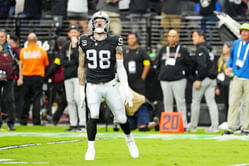
One of the most iconic monuments in sports history and a pillar of the NFL since its present structure, the Superdome has gone by many names but remains an integral part of the league’s lore. The Caesars Superdome has hosted seven Super Bowl games and will be hosting its eighth when the Kansas City Chiefs take on the Philadelphia Eagles in Super Bowl LIX on February 9, 2025. It is a major site for sports events, whether football or basketball.
Officially host to the New Orleans Saints, the Superdome has time-honored traditions that it follows, like the Sugar Bowl, which dates back to 1975. Further, the Bayou Classic and the Tulane Green Wave football team also call the facility their home. During the time of expansion, the New Orleans Jazz called the Superdome its home for 4 years from 1975-1979.
Caesars Superdome Capacity
At maximum capacity, Caesars can hold 73,208 people as a football stadium. However, that number is expandable to 76,468 if necessary. However, the largest crowd, in terms of capacity, that the iconic venue has hosted isn’t for any of these sports. Instead, that crown belongs to Wrestlemania 34 in 2018 when a humongous 78,133 people filtered into the iconic arena. In its nearly 50-year history and nearly 5 years since that event, the number remains untouched. In 2021, 4,300 seats were removed.
New Orleans Saints Home Venue
Located in New Orleans, Louisiana, the Superdome has been the proud home field for the New Orleans Saints for nearly 50 years.
Since 1975, the Curtis and Davis built monument stands as a pillar of greatness in the state of Louisiana. A major draw for sporting events, it has seen 7 Super Bowls played under it with an 8th one coming on February 9th, 2025. Initially the Lousiana Superdome, its naming rights were purchased by Mercedes-Benz in 2011. Almost a decade later, the stadium was sold for a second time, this time to Caesars Entertainment, earning a second name change to the Caesars Superdome.
Caesars Superdome History
In a bid to get the NFL to approve a team in New Orleans, David Dixon thought up the idea of the Superdome. But, after some exhibition games, it was made clear that a domed stadium was a necessity in New Orleans for the NFL to venture there. Along with then-governor, John McKeithen, the duo decided to build a replica of the Astrodome. In a matter of weeks, bonds for the Superdome’s construction were passed in 1966. Just a week later, New Orleans became the host of the 25th professional football franchise.
From 1975 onwards, all of New Orleans matches have taken place in the iconic dome. In January 1978, the Superdome would play host to its first Super Bowl. Its last outing of the event was in 2013. During Hurricane Katrina, the Superdome was used as a shelter of last resort.
One iconic event from its rich history is the Super Bowl XLVII power failure. During the last time, the city played host to the Big Game. the game had a partial power failure that stopped the game for about half an hour in the third quarter. Some cameras and the voiceover were also lost. While the lights eventually came back on, the game eventually commenced without hassle. Eventually, a relay device to prevent electrical overload was cited as the cause of the failure. Thankfully, at no point in time was the Superdome’s power system compromised.
Caesars Superdome Construction and Cost
The idea for the stadium became a hub for all kinds of sports, whether it be football, baseball, or basketball, with the main feature being that it would support movable field-level stands that could be arranged for specific sports. Blount International of Montgomery, AL was chosen to build the stadium. Many mediator variations of the iconic dome, made out of things like sugar or pennies were built as part of exhibitions.
While the initial plan was to have the stadium completed by 1972 political delays cost construction to begin in 1971 with the stadium being ready in 1975. While initial costs put it at nearly $46 million, the price at the end would skyrocket to nearly $165 million due to inflation and the 1973 oil crisis.
The stadium underwent major renovations in 2005 after Hurricane Katrina destroyed parts of it and caused flooding accidents. FEMA contributed $115 million to the project, the state spent $13 million, and the LSED secured $41 million. The NFL paid the rest, totaling nearly $193 million.
Since then, minor renovations have continued to take place, such as the restoration of the roof being the biggest one. Further, an innovative drainage system, escalators, and suite enhancements were also made to the stadium. In 2010, the stadium turned to synthetic turf, more than 110,000 square feet of it, good for the largest continuous synthetic turf system in the NFL. In 2011, nearly 3,500 seats were added to the plaza concourse. Moreover, 7.5K sq. feet of premier bunker loungers were also added to the plaza level.
Current renovations, at the cost of $450 million are underway that should include atriums and an improved concourse. Phase one has already begun.
FAQs on Caesars Superdome
A: Despite hosting basketball, baseball, and of course, football, the largest crowd in attendance for Wrestlemania 34, when more than 78,000 fans were in attendance for the spectacle.
A: Yes, Super Bowl LIX is gonna take place at Caesars Superdome.
A: The Superdome has been sold twice now. First, to Mercedes-Benz in 2011. Now, nearly a decade later, the stadium was bought by Caesars Entertainment, resulting in the once-Louisiana Superdome being called the Caesars Superdome.









![Trevor Lawrence's wife Marissa Lawrence dons classy old-money outfit to explore final 'bits of London' with Jaguars QB [PHOTOS]](https://staticg.sportskeeda.com/editor/2025/10/6c516-17610735204893-1920.jpg?h=166)